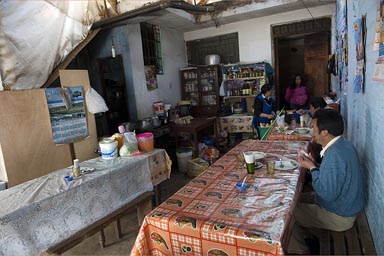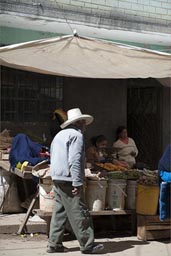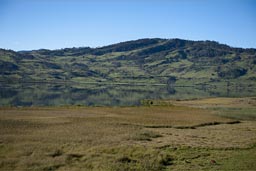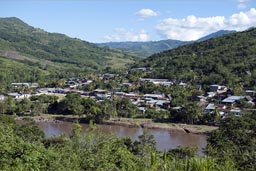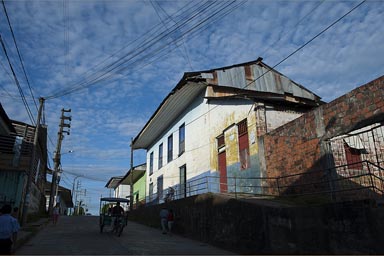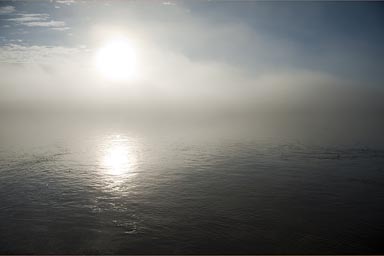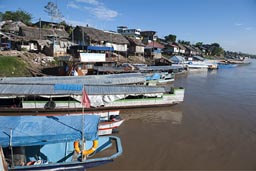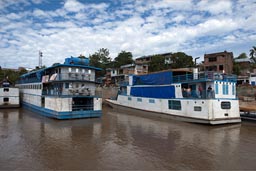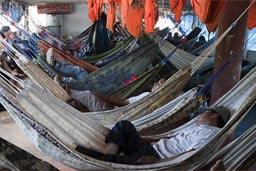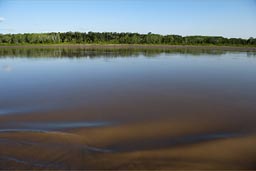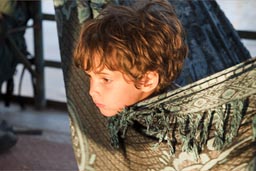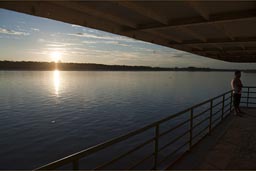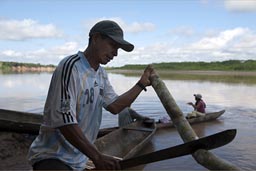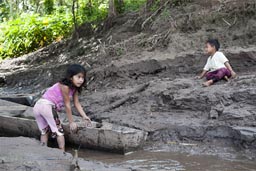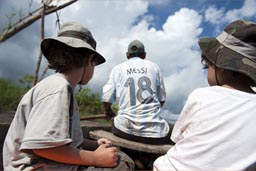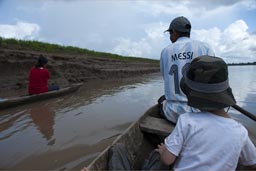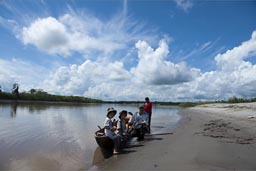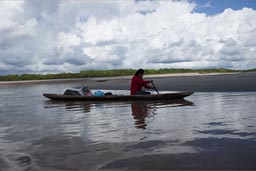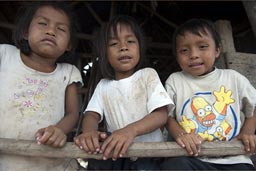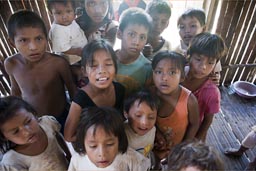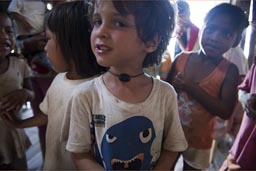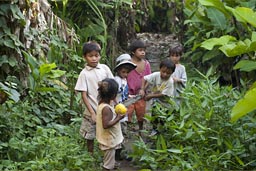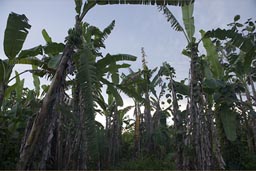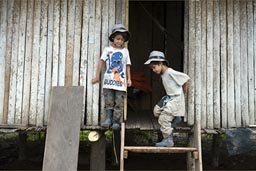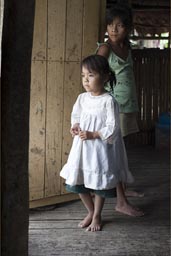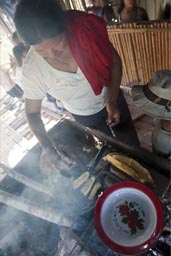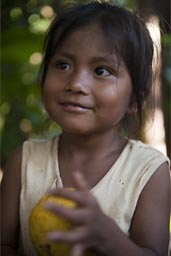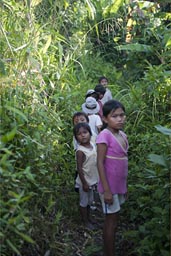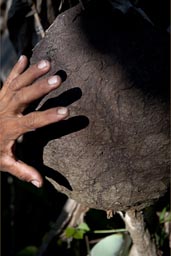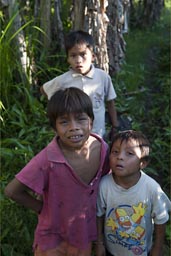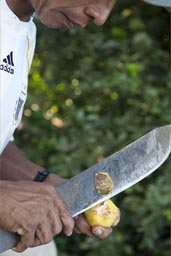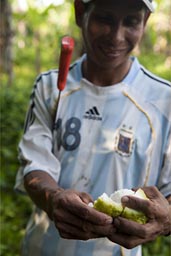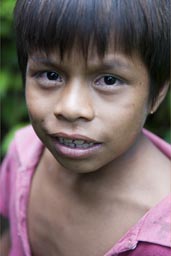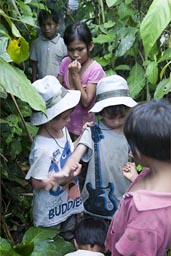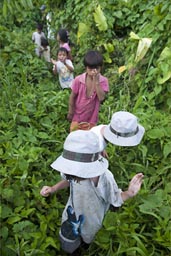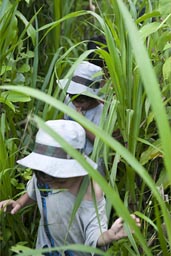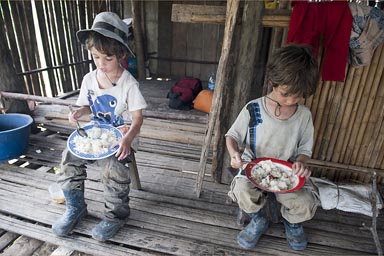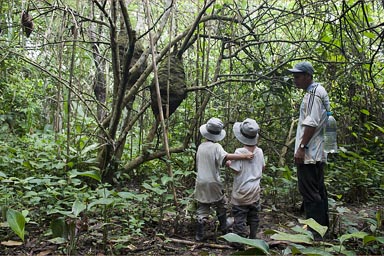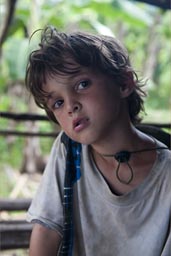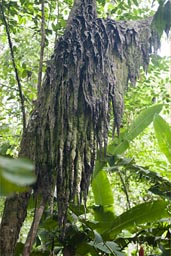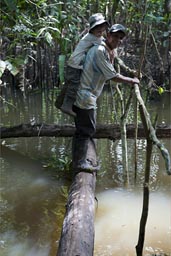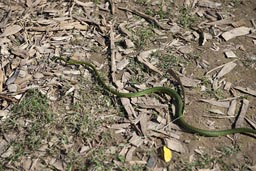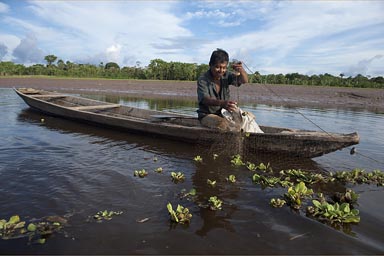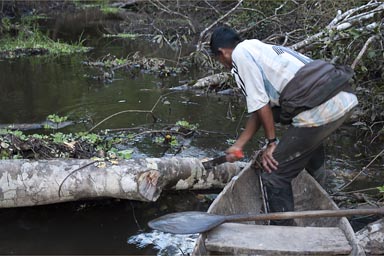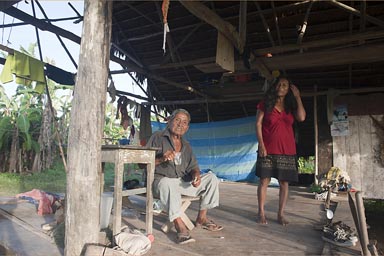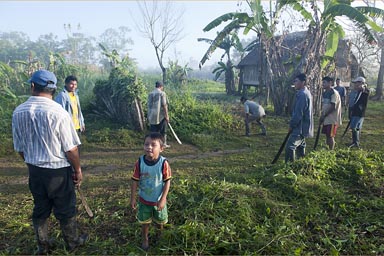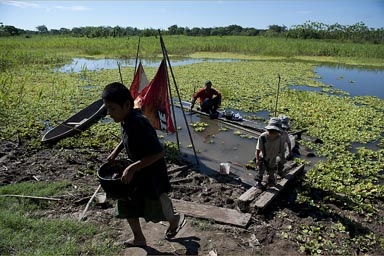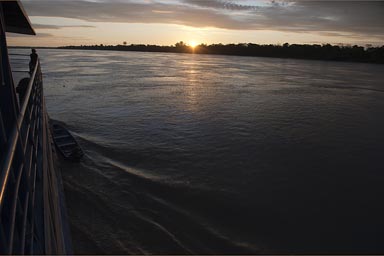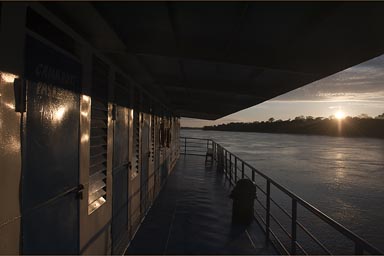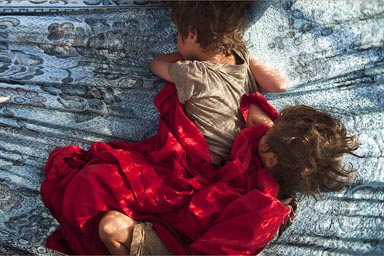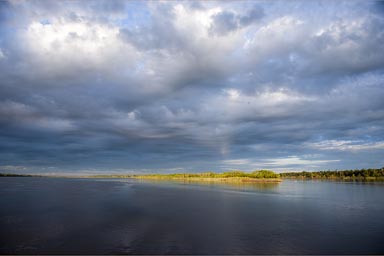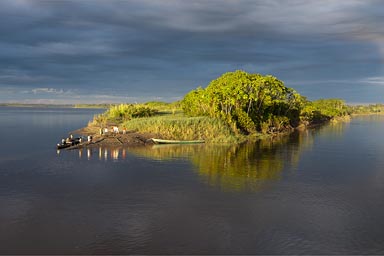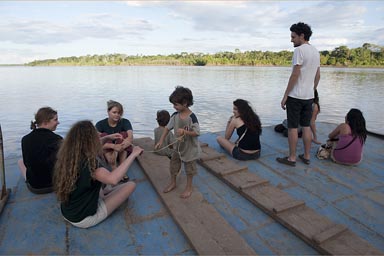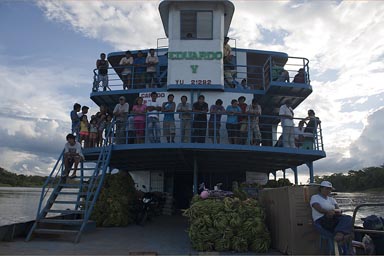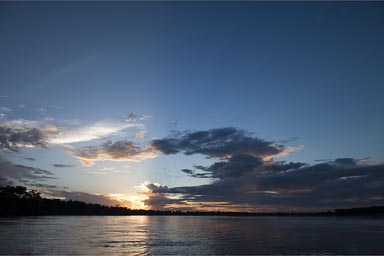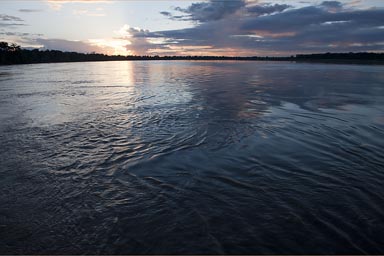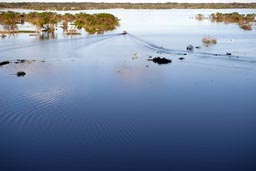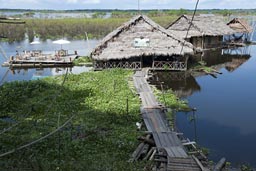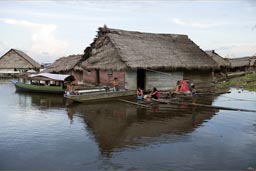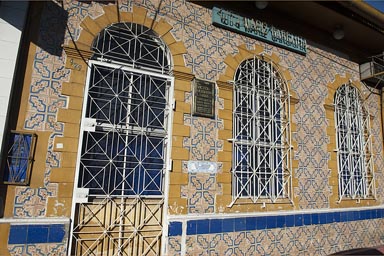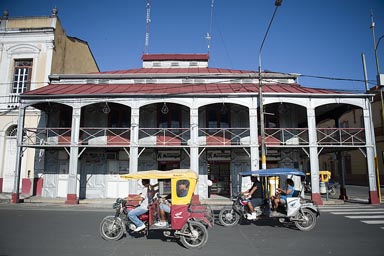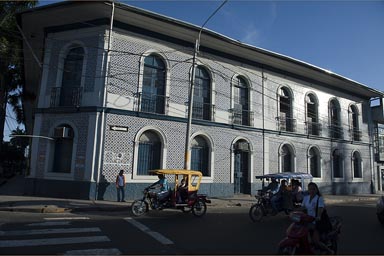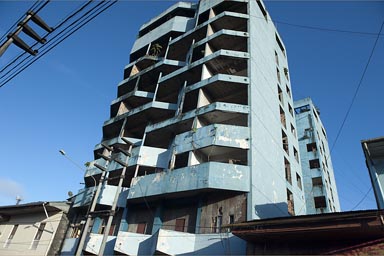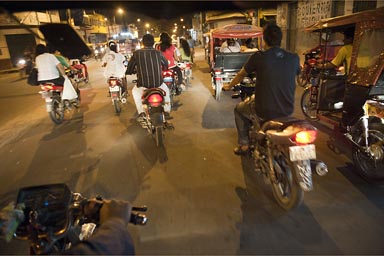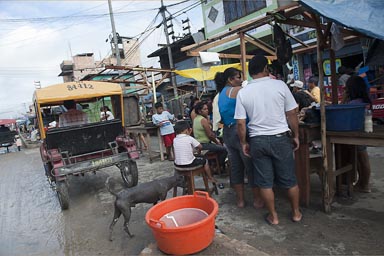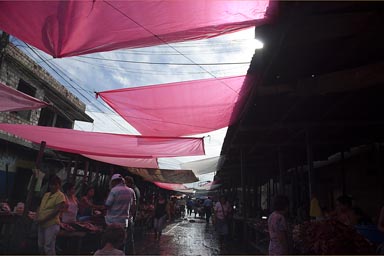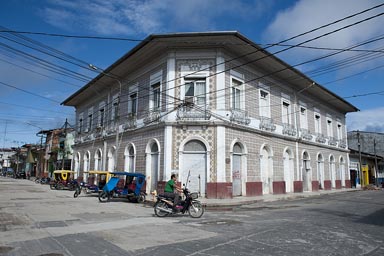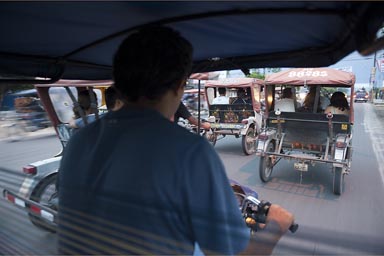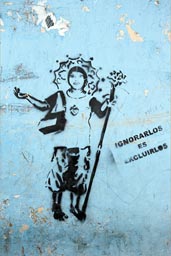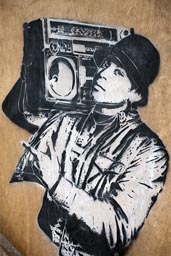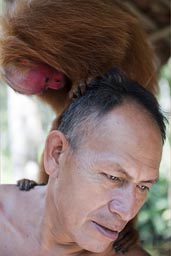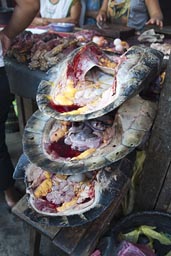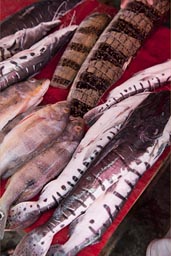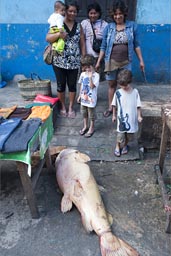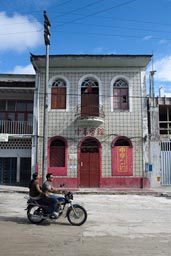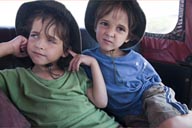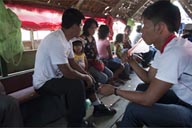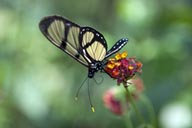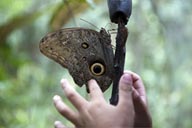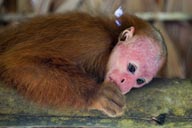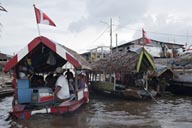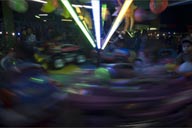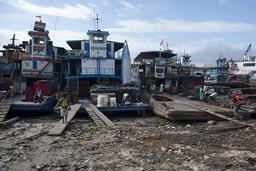www.thisfabtrek.com > journey > south-america > peru > 20120622-iquitos
Over the Andean Mountains down to Bagua.
Download GPS (KML) track/waypoints.
After the encounters with the spines of the Sechura desert near Pampa Grande, we go, as Toño suggested, land inwards, east, on dirt roads first, then cross a river bed and reach a highway, past wine plantations we drive higher and higher up the Andes. And then there are road works, and the newest virgin asphalt soon turns into gravel, later into dirt, the higher we go the more we get into fog and clouds, and then night falls and together with the dust from road building machinery, driving becomes dangerous and not just annoying.
At 2,000m of elevation we break through the clouds, it is dark already, and there is the otherwise sleepy mountain village of Llama, in a cheap restaurant we receive a hearty house soup, we eat with all the people that work on the road building, it is so unusually busy, the boys and their diarrhea keep the toilet busy too. After sleeping on plaza de armas we have breakfast again with the workers, then we drive off, higher before we get to Cutervo in Cajamarca, where men and women wear huge sombreros, this is very much off the beaten track. After cheap lunch in a restaurant behind the market, we are on the road again, winding first for hours, but then it is straight down to the Marañon valley at 450m in altitude. Over the course of the next couple of weeks we would go down stretches of the Marañon river on boat, we would also cross it somewhere further south on our way back into Cajamarca.
Just on this last straight road along rio Chamay the Cajamarca police bug me 3 times, one cop tries bluntly to extract money from me, but hey I received my training with African cops and don't pay them a dime.
There is then a Golden Gate bridge over rio Marañon and we enter Amazonas department and the police remains always on the sides, at the peaje a nice lady asks me where I come from and says 'you can go for free', what a nice reception I think. I am obviously an idiot because I think I don't pay in Amazonas because I am a foreigner, but I am happy in my illusion for about 24 hours.
In Bagua the boys play till late on plaza de armas, Bagua is sleepy. It is also famous for a police massacre 'El Baguazo' in 2009 when hundreds of indigenous demonstrators (against mining and oil-drilling) where gunned down.
Bagua for us is difficult, the diarrhea of the boys is getting worse if anything, the Mancora medication proves useless and we see Dr. Wong who prescribes a different set of antibiotics, against infección intestinal, for me too.
Bagua is hot and little shade, the diarrhea we can heal while we drive, and I have this idea now to go all the way to the east, into the Amazon jungle. So we hit the road, follow picturesque Utcubamba canyon valley with moss over grown ghost trees, but we don't go to Chachapoyas instead take the turn at Pedro Ruiz and climb an Andean range again. High on 2,200m there is a road-side restaurant, white rice for the boys, I have grilled trout, Laguna Pomacochas is near, we went from hot to pretty damn cold again.
We enter San Martin department and slight police hassles are back, in Rioja one officer thinks he is clever and asks me for an international drivers license, which I have, just somewhere, "no es necesita in Peru" I reply and he leaves with all my paperwork, then comes back and hands the boys 2 mandarins, "why don't you buy us mandarins, papa" D&D ask. So I buy mandarins in Moyobamba knowing it is not the best for their diarrhea, at the Claro-office I wonder where all my credit went, understanding my telephone/internet scheme isn't easy. We are already down at 300m, this is the other Peru, at the fringes of the huge Amazon basin. That evening we ride into busy, buzzing Tarapotu, eat fried rice at a Chinese, then buy lots of the new good medicine, for the jungle, also walking boots for the boys and shorts for me, later we sleep near plaza de armas, no beers, no drinks, as we are 'all' on antibiotics.
We board a lancha in Yurimaguas down Huallaga.
It's a short trip but again we drive over 1,000m before we drop to 160m and Yurimaguas in the huge Loreto department, where the road ends and we are ready for the jungle, the Amazon rainforest, and a ship/lancha leaves the next morning down Huallaga River. We leave the van with a señora, and I pay for 8 days in advance, pack the bare minimum for the three of us, sandals and gumboots for the boys, and early morning at 6 we wake and walk straight to the pier. Sun comes up, filters through haze over the huge river while I begin to understand what this journey might be about. No1 is we need is a hammock! There is plenty of time, and it is sold across the pier, but instead of buying two I only buy one, but we only want to go to Lagunas tonight. I hang it up like everybody else, just the boys prefer to run around, make friends, climb where they should not climb, still there is a long time till departure. We part at 11.30 not 8, the boat rides out slowly on the shallow waters of the Huallaga, Lagunas is some 90km away, but the Huallaga meanders make it a 190km journey and the boat crew is always on the lookout for sand banks, also later at night with strong flashlights.
Our lancha is heavily loaded with what ever is needed down the way to Lagunas and onwards, 2 lorries, a bulldozer for works near Lagunas, and anything in food staples, live animals and building materials and we stop every-so-often for loading/unloading. 30 Soles, just over one USD is my ticket to Lagunas, kids go for free, I pay the local price, lunch and dinner is prepared and included in the ticket, they give me a bit more so I can feed my boys too. Golden sets the sun over the jungle, to our great delight some sweet water dolphins jump, appear several times for air-intake as our boat chugs on in the dirty brown ocean-like stream.
At 7 I bed the boys in the hammock, and roll myself into the sleeping bag on the floor, I didn't even bring a jacket, fool. No threats from thieves here told me Toño, "thieves they throw them in the water". I sleep! At 1 in the morning we land in dark Lagunas, find a hostel and sleep on.
Near Lagunas into the jungle, rainforest and a Cocama Cocamilla village.
On the ship we have met German Jana, the only other non-Peruvian. Unlike us Jana is better prepared, she knows where she's going, has had a tour booked in advance, and it is Jana who calls us this early morning at 7, asking whether the boys and I would want to join her on her canoe tour to the rainforest. So before we can think we are on the way, in a rickshaw motorcycle and on a canoe upstream Huallaga. It cannot be any better, nor cheaper, I wanted to show the boys the jungle, the river, the rainforest, promised the adventure, it would take me a day to get organized, at least.
Our boat people are Ribert and his wife Nuria, Nuria paddles the second canoe with all the luggage, water and some food staples. We travel a total of 12kms upstream, the river is calm, sun beats down hot, there aren't even mosquitoes, later the rains come and drum strongly on the ponchos that we strip over and D&D seek shelter underneath mine, and David falls asleep during the rains and after. We spot again the sweet water dolphins but the river has two species of fish that can be perilous, Piranhas and 'spaldas', as Ribert calls them and he shows us his scars from 'spalda' attacks, so I keep telling the boys to keep their hands out of the water.
We land in the pueblo of 8th of October on rio Huallaga, a Cocama Cocamilla community, defined by the Amazon Cocamilla language group, which is spoken by about 2,000 people (ethnologue), it is one of maybe 1,000 languages in the Amazon basin. Nurias whole family lives here, all the houses are built on poles, as a bit earlier in the year all is a half a meter under water. Later before nightfall we go on a walk in the half jungle/half plantations, and a dozen children of all age come with us. I am primarily concerned with snakes, deep grass and there are hundreds, that's common knowledge, not let's fool ourselves, just usually nothing happens. This is no real jungle but banana plantations between the swamps, and the village lives off the bananas, but it has all sorts of wild oranges or super-sized jungle lemons, 'toranjas', and much other wild rainforest fruit trees tossed in between too, and Ribert shows it all, cuts it up, names it, and it is hard to remember.
We come back too late, sun has set and the mosquitoes started their onslaught. The risk for malaria is very low, but I get bitten hundreds of times while I wash the boys, put them under the net, and finally get underneath myself sweating, without food, in the house on poles that threatens to fall apart, and I wonder whether it will stand during the next rainy season; really the poles are rotten, the roof leaks, there are rains this night, our shattered hut rattles in a storm while I have a guy climbing high above us to fix a plastic, so we won't get wet.
My boys, I realize are big boys, there is no room for me under the net, they take all the space, lie diagonal, the ground is hard, I feel the gaps between the planks on my hips and ass, it is round as bamboo but is not bamboo, all night in pain, there's only a thin blanket to soften the ground, and I sweat and scratch my bites, truly the most horrible night on my journeys. The boys though sleep their usual sweet slumber.
The night is short for me, I find sleep eventually, or occasionally, in total not much, and the guy next door, or is it Ribert, starts playing his radio at full volume at 5 in the morning. There is no concept of letting others sleep, nobody thinks about the other, or is it that people don't feel 'our' western annoyances annoying? At 6.30, while sun comes out nicely, the mosquitoes still come down hard until about 10. I light a toxic spiral that keeps them a bit at bay, dry my socks over the fire and drink coffee. Breakfast later is cooked fish, yuca, plantains, and rice, nothing has much taste, the boys eat rice only; better for them. They are then off playing most of the time, go far with all the children, it is tranquil. Just Jana is sick with maybe a sun stroke, maybe something else, great pain from the stomach, Ribert prepares jungle tea of roots, and Nuria provides some rubbings of plants on chest and stomach.
So the boys get rice with rice, and then we walk into the selva/jungle, the three of us and Ribert.
After a while Ribert, and us too, hear the breaking of branches, and think it is monos/apes/monkeys, but it's just people from the community that work on a clearing for a new corn field. We won't see any mammals, nor snakes, just spiders, centipedes, butterflies, and some shy birds. But we cross a deep jungle stream, 5 meters deep, to the excitement of the boys, over a trunk that has fallen, and the stream is full of fish, piranhas too, the waters this year were exceptionally high, fish stock is rich. Ribert builds a reiling and we cross, he carries the boys, one by one, the trunk is slippery. Behind not far then the swamps start and there for sure live caymans, 3-5 meters long, as Ribert puts it, crocodiles, alligators, whatever they are, they can kill man, he says. We won't see them and return to camp for lunch, eggs, yuca, plantains, rice, always the same in la selva. It was quite an adventure for the D&D.
Needless to say when we return there is a snake where we sleep, a green one, non poisonous. Not let's fool ourselves, there are thousands.
At 3.30 afternoon another adventure starts and Jana is better, thanks to jungle medicine and comes along. Ribert and the four of us return to the banks of the Huallaga river, scoop out the water from the submerged canoe, board it and cross the river. After a while upstream we enter a side arm. The bird life becomes more active at dawn, we still hope to see monos. Our passage on the stream is barraged many times by entire fallen trees, we have to cut our way free and Ribert uses his machete with great efficiency. Later night falls over some original big trees, the milky way shines above, with the Southern Cross to our left. No crocs, no monkeys, some toads, spiders, small turtles, fireflies in the thousands, plenty of fish as usual, plenty of electric fish, many jump high, entire swarms go wild, some jump into our boat and you have to grab them, find them in the dark and throw back into the water. Yes darkness comes over us quickly when some barrage makes going any farther impossible, this is the point of return. We paddle downstream, all of us, fast, silent, under the stars, with the occasional attack by small jumping fish, and the boys sleep an early sleep after an exiting, an amazing day.
We come back and the mosquitoes are again aggressive, I am again fast and bed the boys, just this time in the other corner under the net, and I sleep with additional padding under my hips, so the second night is a bit better.
Morning light is soft, the villagers are out early, for cleaning and cutting grass, community work on Saturday. An old man comes to me and shows me a brochure 'La Atalaya', 'Watchtower', the Jehovah Witnesses paper, and he asks me about my believes, he is completely taken by what he reads in there, he comes several times, to convert me. 'Even here', I think, officially all is 100% catholic, but the junk religions make inroads.
It is an easy morning and I dry my socks over the fire, read my book and write my diary. Daniel and David are off, stripped themselves earlier off their sandals, run around bare feet like all other children, chase chicken and ducks and chicklings and ducklings, gather caracoles/snails' shells, wash them in the swamps. Some children come running, interrupt my reading, David, while playing on a canoe, pushes himself off, I can convince him to paddle back. One child is a bit an outsider, he has the strange looks, slight mongolism, he stares into my book while I read, into my diary while I write. Lunch is grilled fish again from the back waters, obviously my boys dislike it, stick to white rice.
We thank and shake hands with everybody and board the canoes back downstream Huallaga to Lagunas. Just there is one problem, we have run out of drinking water and they offer water from the river, I put some purification tablet inside, the brown brew still tastes so awful, it is impossible to drink, and better for our persistent diarrhea. Just the sun beats down hard and we arrive slightly dehydrated. I give Ribert a sound tip, tell him it is from all of us, and then all I can think of is a beer, the first in 5 days, and the boys get their long promised Fanta.
The story of Lagunas goes a bit like this: It was found by a family of indigenas in 16-something who where forced off their former lands by enormous inundations, and they found higher grounds around here. The tribe was subsequently almost wiped out by an epidemic that killed 500 people, only some men and women left and escaped the malaise to return years later, 17 something. In the earlier 19-hundreds the Españolas arrived when the caoutchouc business started, and the rubber attracted many, evangelicals, Germans, Jews, mestizos, indigenas of the Cocama Cocamilla people and Lagunas grew.
Today it lives of tourism and the fish from the rich back waters. Whites (mestizos/Españolas) and indigenas live segregated and it is big business on both sides for the evangelicals of all colors. It is Sunday and drumming and chanting can be heard from every corner all day long from the dawn of the day till past nightfall. Everybody is a catholic at heart but they all and women especially, have reasons to attend the evangelical's services and preachers, 'because the nice lady teaches my daughter to paint'.
Our host ladies go Sunday morning's to play bingo, to the evangelicals later in the afternoon. The old host gets completely drunk in a bar all day, leaves in the morning, is being carried back home just before dark and would not be able to say his name anymore; such is a good Sunday.
At 3 the chief host comes and tells us there wouldn't be a boat today to Iquitos. 'Bullsh!t' I think and go and check myself at the puerto, and off course there is a boat, late. Never trust, always check is the old rule.
We go to the pier at 8, Ribert comes along, asks Jana for more money, he's been drinking, and all is gone.
At Lagunas port there are no facilities, all is so dirty, the boys are so tired and they fall asleep standing. I wake them at 10.30, they don't know what is going on and cry. We board the lancha at 11, I carry two boys and my backpack over the mud of the huallaga banks. I tie up our hammocks, and I was wise and bought a second one, and we sleep a sound sleep amongst so many others in their hammocks, on top of chicken, parrots, turtles, sacks of rice and corn, while our ship floats downstream what is now the Marañon River; here we meet him again.
I am up before sunrise, and the boys sleep their beautiful boy's sleep. Light is so mellow.
Iquitos.
On rio Marañon we meander for some 40 hours, down some 550kms, then we dock in Iquitos and this is already called the Amazon River. If there is a place far away it is Iquitos, it has no road connection and is Peru's sixth largest town in the middle of the Amazon rainforest, a gateway to Brazil and Ecuador and we could go up south the Ucayali to Pucallpa, but really how many more days do I want to spend on a boat?
In Iquitos first I think the diarrhea should be dealt with, but than it is all back as if nothing was ever done for or against it, so we see Dr. Antonioli to combat the other, next diarrhea, or the same old damn cow. An analysis detects salmonellae, and we are on yet another set of antibiotics. Reading about Werner Herzog's Fitzcarraldo film I feel myself in a similar uphill struggle where it is clear that you will never win; and in fact I wish I could see this 1982 movie with Kinski and Cardinale, its producer apparently lives in Iquitos (wiki). The other struggle out of this world is a slow internet connection; come on it was better in Atar in 2005, and that is surrounded by a lot of sand in the middle of Mauritania. You would think 2012 Iquitos has a better infrastructure. There is a nice floating bar on the river and sometimes in the afternoon it gets chilly and the San Juan winds blow in a change in weather from the south, and I, fool, still have no jacket.
The water levels have already come down some 7 meters, tells me Walter, an Austrian who I meet here on the floating bar and has been living in Iquitos for 5 years, and this is less than a month after the highs. The amplitude is 13 meters and it has been record highs this year, but people live with the high water, he continues, in the house on poles they put in a second floor than another one if necessary. It is the high waters that produce these massive amounts of fish. And here on the planks between the homes and next door Daniel and David run around, climb in the boats, never miss-step, fish with the indigenous boys and girls from next door, I soon have to call them from their homes, this bar is golden, and the music-mix to my great surprise African. The owner is of Jewish origin, our family was one of the first to come here, mid 19th century, long before the rubber boom, and there was nothing, he declares proudly.
The 1880s an the rubber barons brought the architectural wealth to Iquitos, Spanish, Portuguese and French mixed with Amazon styles, many houses were decorated with ceramic tiles and one with iron sheets, built by Gustaf Eifel. Inbetween you find the odd concrete ruin from just very recently.
Apart from that the city is characterized by its rickshaw motorcycle traffic, and the twins enjoy every ride we take, and the markets, where anything from alligators, turtles, dolphins, to the strangest Amazon rainforest creatures is sold, mostly for food, some for healing.
It is the San Juan festivities that keep us here, which are the greatest festivities in the jungle, but what ever I expected it turns out to be not much else than a big amusement park, where the boys can have fun on the carousel and the trampolines. We want to be careful, 'a third come to pray to San Juan, a third come to drink, and a third come to steal', this is how someone put it.
But really that is it, apart from the butterfly farm, which comprises a rickshaw ride, than a lancha ride, howler monkeys and a jaguar, a full adventure for D&D.
The nice thing about Iquitos is the coming, the endless lancha ride, and the going, another endless journey on the big Amazon tributaries, the days and days on the water, the changing weathers, the rains that blow over the vast open jungle, it is an eyeopener of sorts, this is the way to understand how big it really is, the great Amazon rainforest.
We board the Eduardo V ship back to Yurimaguas on Monday the 25th of May afternoon, leave at 5.30 full on schedule, hang up our two hammocks, and sail into the cool night, upstream the Amazon, later the Marañon. San Juan truly brought the cold southern winds, it rains all night and morning, I am glad I bought a jacket, finally a hero. On this journey I hardly eat and have a hard time surviving, as the boys dig in all the comida that runs on my ticket, I try to better my lot by buying hard boiled eggs off the crew.
One afternoon we dock on the same headland in the Marañon, indigenas storm on board with parrots and turtles in all sizes for sale as pets, and nearly all passengers contemplate buying one, not realizing that the animal will be with them all their remaining life, their feathers, peaks, claws cut, some very hurtful to the feathered beasts.
At the same time 3 pink dolphins so near to the boat emerge and reemerge for air-intake, one bored idiot throws a coke bottle at them. Loreto from all of Peru has an education level as poor as Africa, appalling for Peru in 2012, it couldn't do a worse job in the pride of the Amazon River basin. We push away from headland and the skies open for the torrents, as if to say "Yes it is sad, but still so beautiful". And it whispers in my ear: "Hey it's time you come to terms with South America!"
On the third day I hear the screeching of a pig, and the boys come running, "they're cutting up a pig, with a knife, and now it is dead, and then they come again, "they are taking his jacket and hair off, and cutting it in half, hold his feet", I tell them that it is for soup today, "I don't want to eat pig" they say.
Time passes and the jungle around doesn't change much. After 3 days and 3 nights we arrive in Yurimaguas, and the diarrhea of the boys seems gone, 'cause I forbade them every local juice and ice cream made of whatever water.
www.thisfabtrek.com > journey > south-america > peru > 20120622-iquitos

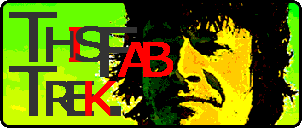
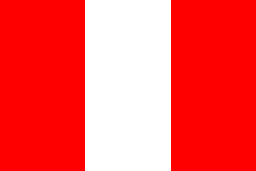
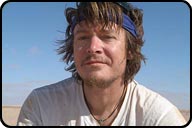
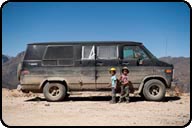


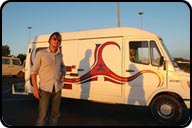
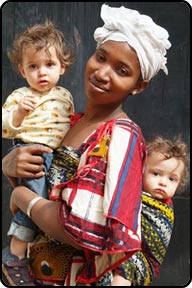
 contains Festival/Fiesta/Art photography.
contains Festival/Fiesta/Art photography.
